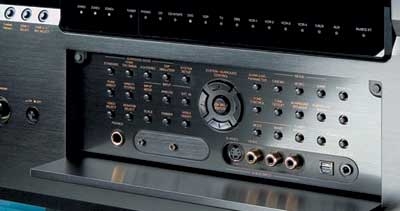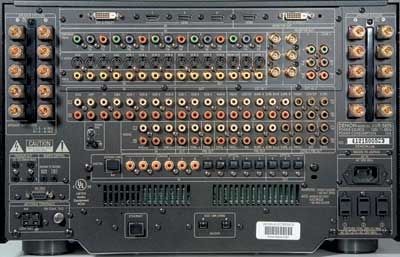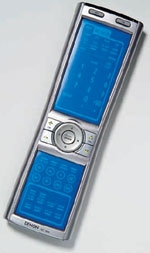Denon AVR-5805 Digital Surround Receiver Page 2
SETUP Aside from the sheer physical effort of wrestling the 97-pound beast onto my rack, most of the setup was typical. The exceptions: running the auto-EQ routine and setting up a second home theater system in my home to test the receiver's special multiroom capabilities. 
To run the auto-setup and auto-EQ routines, you begin by placing the microphone at the listening position. Denon's hockey-puck-shaped DM-S305 test mike is a $100 option that the company lent me for our test. Sure, you can use any measurement mike, and in most cases the dealer will set up the receiver for you, but it seems kind of chintzy not to include the mike when less-expensive models supply one.
Once the mike is in place, you just cue auto-setup on the remote and brace yourself for a series of swooping chirp sequences from each speaker. Go have a cup of joe and read the paper in another room for 15 minutes - and restrain your dog, which I guarantee will go postal. Auto-EQ involves a shorter chirp sequence but requires moving the mike and repeating the routine at each listening position, allowing the Audyssey software to collect data from each one to create an average response curve. I averaged three spots - you can do as many as six, but the more you average, the less ideal the correction will be at any one, including your primary listening spot.
A bit more challenging was the task of running a bundled umbilical of five long speaker wires plus RCA patch cords from my studio's home theater into our TV room some 40 feet down the hall. One of the AVR-5805's myriad setup menus (which in their multitudes are actually very straightforward) let me assign five speaker outputs to the remote room's front and surround speakers. The long RCA cable from the remote subwoofer went to the SW jack in the Denon's Zone 2 preamp-out grouping.
Of course, running two 5.1-channel systems like this occupies all ten powered channels and precludes having back surround speakers in either room for a 6.1- or 7.1-channel system. You could add a power amp and drive it from the preamp outs, but most owners will more likely use the Denon's capacity for multiple stereo or mono zones rather than a second home theater. A three-zone system of 6.1 + 2.0 + 2.0 seems to me a good deployment of forces. 
PERFORMANCE Let me say this upfront: judged purely on sound quality, the Denon AVR-5805 really delivers the goods. It had plenty of power for my moderately low-sensitivity 6.1-channel speaker layout. After watching Friday Night Lights and replaying some of the more violent gridiron collisions a few times at true cinema levels, I had to restrain myself from stopping by the walk-in clinic for X-rays. And the Denon sounded equally superb on whatever I sent its way: multichannel music, stereo, movies. This is one of a three-fingered-handful of A/V receivers I've tried that have come close to equaling the sonic chops of my reference preamp/processor and power-amp setup. And the Denon came closest of all - which it damned well should, as it costs (and nearly weighs) just as much.
|
I was even more impressed when I engaged the Denon's auto-calibrated room EQ. The AVR-5805 offers three EQ settings besides manual (do it yourself): Flat, Front (normalized), and Audyssey (a full room-correction setting), among which the last clearly gave the most accurate results. Audyssey made all sources sound noticeably brighter - which took a bit of getting used to - but it did so without the added "edge" or "spittiness" you often get when you turn up a treble control. And the improvements were obvious: enhanced definition, less bass heaviness, and improved spatial clarity. Denon's new room EQ is something serious listeners should definitely check out.
My temporary second home theater worked fine, too. This was just a test, though: because I didn't have the optional Denon remote-control-extender components on hand, I used "sneaker net" to make selections and adjustments, running from room to room. Obviously, in a real installation, a remote link - whether Denon's or a third-party equivalent - would be a key part of the setup.
 Speaking of remotes, the RC-995 Denon supplies with the AVR-5805 is a preprogrammed/learning model that handles up to 12 components and 3 zones. The membrane-switch "keys" are behind a flat luminescent panel. Only the labels you need light up at any one time, drastically reducing visual clutter. Though it was hard to read in bright sunlight, I liked it a lot. Still, Denon's failure to bundle its premium RC-8000 touchscreen remote with this statement piece may be seen as a snub by some of its six-grand-a-pop customers.
Speaking of remotes, the RC-995 Denon supplies with the AVR-5805 is a preprogrammed/learning model that handles up to 12 components and 3 zones. The membrane-switch "keys" are behind a flat luminescent panel. Only the labels you need light up at any one time, drastically reducing visual clutter. Though it was hard to read in bright sunlight, I liked it a lot. Still, Denon's failure to bundle its premium RC-8000 touchscreen remote with this statement piece may be seen as a snub by some of its six-grand-a-pop customers.
Really, Denon has made the AVR-5805 about as easy to operate, and to live with, as you can reasonably expect for so intricate a product. The menu structure is logical, and the manual is generally clear and concise for all its 191 pages. And the portly powerhouse is itself a blast to listen to and use.
BOTTOM LINE Don't buy the Denon AVR-5805 if you're not going to exploit at least a good part of its special abilities. If you don't need its multiroom expertise, if you're not going to bother with the Audyssey auto-EQ and auto-setup, if you don't care about video scaling and upconversion, HDMI, or digital connections for DVD-Audio and SACD, then keep on walking. On the other hand, if you can truly use ten 170-watt channels, if you honestly relish drilling down into menus and features to get the full yield of techno-functionality, if you have more than good intentions about finally setting up a whole-house media layout - and if you're the type who routinely finds a $6,000 bill in your wallet - go for it. You will not be disappointed.
- Log in or register to post comments








































